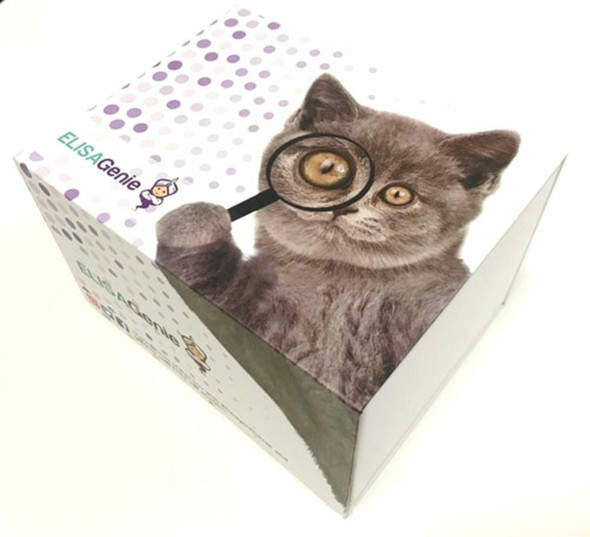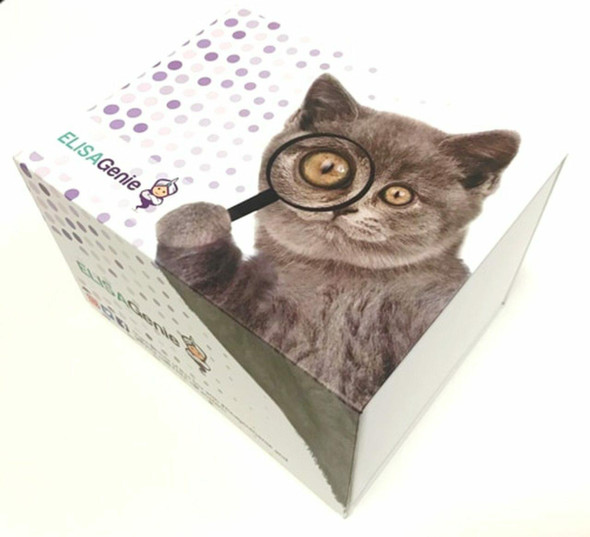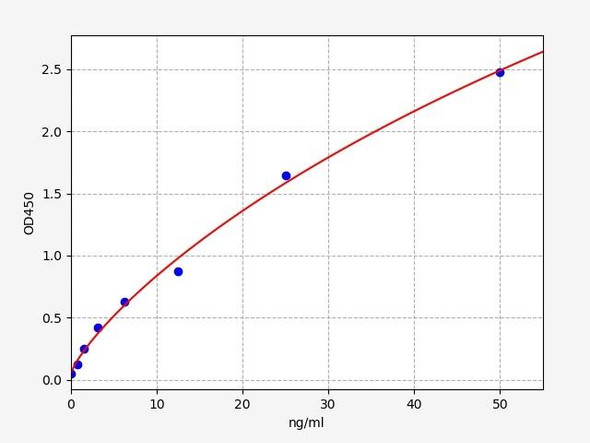Human Cardiovascular ELISA Kits
Human TAFI (Thrombin Activatable Fibrinolysis Inhibitor) CLIA Kit (HUES01125)
- SKU:
- HUES01125
- Product Type:
- ELISA Kit
- ELISA Type:
- CLIA Kit
- Size:
- 96 Assays
- Sensitivity:
- 0.56ng/mL
- Range:
- 0.94-60ng/mL
- ELISA Type:
- Sandwich
- Reactivity:
- Human
- Sample Type:
- Serum, plasma and other biological fluids
- Research Area:
- Cardiovascular
Description
| Assay type: | Sandwich |
| Format: | 96T |
| Assay time: | 4.5h |
| Reactivity: | Human |
| Detection method: | Chemiluminescence |
| Detection range: | 0.94-60 ng/mL |
| Sensitivity: | 0.56 ng/mL |
| Sample volume: | 100µL |
| Sample type: | Serum, plasma and other biological fluids |
| Repeatability: | CV < 15% |
| Specificity: | This kit recognizes Human TAFI in samples. No significant cross-reactivity or interference between Human TAFI and analogues was observed. |
This kit uses Sandwich-CLIA as the method. The micro CLIA plate provided in this kit has been pre-coated with an antibody specific to Human TAFI. Standards or samples are added to the appropriate micro CLIA plate wells and combined with the specific antibody. Then a biotinylated detection antibody specific for Human TAFI and Avidin-Horseradish Peroxidase (HRP) conjugate are added to each micro plate well successively and incubated. Free components are washed away. The substrate solution is added to each well. Only those wells that contain Human TAFI, biotinylated detection antibody and Avidin-HRP conjugate will appear fluorescence. The Relative light unit (RLU) value is measured spectrophotometrically by the Chemiluminescence immunoassay analyzer. The RLU value is positively associated with the concentration of Human TAFI. The concentration of Human TAFI in the samples can be calculated by comparing the RLU of the samples to the standard curve.
| UniProt Protein Function: | CPB2: Cleaves C-terminal arginine or lysine residues from biologically active peptides such as kinins or anaphylatoxins in the circulation thereby regulating their activities. Down- regulates fibrinolysis by removing C-terminal lysine residues from fibrin that has already been partially degraded by plasmin. Belongs to the peptidase M14 family. 2 isoforms of the human protein are produced by alternative splicing. |
| UniProt Protein Details: | Protein type:EC 3. 4. 17. 20; Secreted, signal peptide; Secreted; Protease Chromosomal Location of Human Ortholog: 13q14. 11 Cellular Component: extracellular space Molecular Function:zinc ion binding; metallocarboxypeptidase activity Biological Process: response to drug; fibrinolysis; negative regulation of fibrinolysis; response to heat; blood coagulation; proteolysis |
| NCBI Summary: | Carboxypeptidases are enzymes that hydrolyze C-terminal peptide bonds. The carboxypeptidase family includes metallo-, serine, and cysteine carboxypeptidases. According to their substrate specificity, these enzymes are referred to as carboxypeptidase A (cleaving aliphatic residues) or carboxypeptidase B (cleaving basic amino residues). The protein encoded by this gene is activated by trypsin and acts on carboxypeptidase B substrates. After thrombin activation, the mature protein downregulates fibrinolysis. Polymorphisms have been described for this gene and its promoter region. Alternate splicing results in multiple transcript variants. [provided by RefSeq, Jun 2013] |
| UniProt Code: | Q96IY4 |
| NCBI GenInfo Identifier: | 317373332 |
| NCBI Gene ID: | 1361 |
| NCBI Accession: | Q96IY4. 2 |
| UniProt Secondary Accession: | Q96IY4,Q15114, Q5T9K1, Q5T9K2, Q9P2Y6, A8K464, |
| UniProt Related Accession: | Q96IY4 |
| Molecular Weight: | 423 |
| NCBI Full Name: | Carboxypeptidase B2 |
| NCBI Synonym Full Names: | carboxypeptidase B2 (plasma) |
| NCBI Official Symbol: | CPB2 |
| NCBI Official Synonym Symbols: | CPU; PCPB; TAFI |
| NCBI Protein Information: | carboxypeptidase B2; carboxypeptidase R; carboxypeptidase B-like protein; thrombin-activable fibrinolysis inhibitor; thrombin-activatable fibrinolysis inhibitor; carboxypeptidase B2 (plasma, carboxypeptidase U) |
| UniProt Protein Name: | Carboxypeptidase B2 |
| UniProt Synonym Protein Names: | Carboxypeptidase U; CPU; Plasma carboxypeptidase B; pCPB; Thrombin-activable fibrinolysis inhibitor; TAFI |
| Protein Family: | Carboxypeptidase |
| UniProt Gene Name: | CPB2 |
| UniProt Entry Name: | CBPB2_HUMAN |
As the RLU values of the standard curve may vary according to the conditions of the actual assay performance (e. g. operator, pipetting technique, washing technique or temperature effects), the operator should establish a standard curve for each test. Typical standard curve and data is provided below for reference only.
| Concentration (ng/mL) | RLU | Average | Corrected |
| 60 | 35264 39062 | 37163 | 37138 |
| 30 | 15887 16071 | 15979 | 15954 |
| 15 | 7910 6832 | 7371 | 7346 |
| 7.5 | 3386 3740 | 3563 | 3538 |
| 3.75 | 1862 1704 | 1783 | 1758 |
| 1.88 | 964 884 | 924 | 899 |
| 0.94 | 498 506 | 502 | 477 |
| 0 | 25 25 | 25 | -- |
Precision
Intra-assay Precision (Precision within an assay): 3 samples with low, mid range and high level Human TAFI were tested 20 times on one plate, respectively.
Inter-assay Precision (Precision between assays): 3 samples with low, mid range and high level Human TAFI were tested on 3 different plates, 20 replicates in each plate.
| Intra-assay Precision | Inter-assay Precision | |||||
| Sample | 1 | 2 | 3 | 1 | 2 | 3 |
| n | 20 | 20 | 20 | 20 | 20 | 20 |
| Mean (ng/mL) | 2.76 | 6.35 | 26.06 | 2.50 | 6.17 | 23.90 |
| Standard deviation | 0.22 | 0.68 | 1.96 | 0.30 | 0.71 | 1.85 |
| C V (%) | 7.97 | 10.71 | 7.52 | 12.00 | 11.51 | 7.74 |
Recovery
The recovery of Human TAFI spiked at three different levels in samples throughout the range of the assay was evaluated in various matrices.
| Sample Type | Range (%) | Average Recovery (%) |
| Serum (n=5) | 98-111 | 105 |
| EDTA plasma (n=5) | 95-106 | 100 |
| Cell culture media (n=5) | 94-106 | 99 |
Linearity
Samples were spiked with high concentrations of Human TAFI and diluted with Reference Standard & Sample Diluent to produce samples with values within the range of the assay.
| Serum (n=5) | EDTA plasma (n=5) | Cell culture media (n=5) | ||
| 1:2 | Range (%) | 102-116 | 93-109 | 91-104 |
| Average (%) | 110 | 101 | 98 | |
| 1:4 | Range (%) | 88-100 | 92-103 | 101-117 |
| Average (%) | 94 | 97 | 107 | |
| 1:8 | Range (%) | 89-103 | 97-110 | 96-109 |
| Average (%) | 96 | 104 | 102 | |
| 1:16 | Range (%) | 94-111 | 95-110 | 88-99 |
| Average (%) | 102 | 101 | 93 |
An unopened kit can be stored at 4°C for 1 month. If the kit is not used within 1 month, store the items separately according to the following conditions once the kit is received.
| Item | Specifications | Storage |
| Micro CLIA Plate(Dismountable) | 8 wells ×12 strips | -20°C, 6 months |
| Reference Standard | 2 vials | |
| Concentrated Biotinylated Detection Ab (100×) | 1 vial, 120 µL | |
| Concentrated HRP Conjugate (100×) | 1 vial, 120 µL | -20°C(shading light), 6 months |
| Reference Standard & Sample Diluent | 1 vial, 20 mL | 4°C, 6 months |
| Biotinylated Detection Ab Diluent | 1 vial, 14 mL | |
| HRP Conjugate Diluent | 1 vial, 14 mL | |
| Concentrated Wash Buffer (25×) | 1 vial, 30 mL | |
| Substrate Reagent A | 1 vial, 5 mL | 4°C (shading light) |
| Substrate Reagent B | 1 vial, 5 mL | 4°C (shading light) |
| Plate Sealer | 5 pieces | |
| Product Description | 1 copy | |
| Certificate of Analysis | 1 copy |
- Set standard, test sample and control (zero) wells on the pre-coated plate and record theirpositions. It is recommended to measure each standard and sample in duplicate. Note: addall solutions to the bottom of the plate wells while avoiding contact with the well walls. Ensuresolutions do not foam when adding to the wells.
- Aliquot 100 µL of standard solutions into the standard wells.
- Add 100 µL of Sample / Standard dilution buffer into the control (zero) well.
- Add 100 µL of properly diluted sample (serum, plasma, tissue homogenates and otherbiological fluids. ) into test sample wells.
- Cover the plate with the sealer provided in the kit and incubate for 90 min at 37 °C.
- Aspirate the liquid from each well, do not wash. Immediately add 100 µL of BiotinylatedDetection Ab working solution to each well. Cover the plate with a plate seal and gently mix. Incubate for 1 hour at 37 °C.
- Aspirate or decant the solution from the plate and add 350 µL of wash buffer to each welland incubate for 1-2 minutes at room temperature. Aspirate the solution from each well andclap the plate on absorbent filter paper to dry. Repeat this process 3 times. Note: a microplatewasher can be used in this step and other wash steps.
- Add 100 µL of HRP Conjugate working solution to each well. Cover with a plate seal andincubate for 30 min at 37 °C.
- Aspirate or decant the solution from each well. Repeat the wash process for five times asconducted in step 7.
- Add 100 µL of Substrate mixture solution to each well. Cover with a new plate seal andincubate for no more than 5 min at 37 °C. Protect the plate from light.
- Determine the RLU value of each well immediately.






